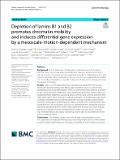Depletion of lamins B1 and B2 promotes chromatin mobility and induces differential gene expression by a mesoscale-motion-dependent mechanism
Author(s)
Pujadas Liwag, Emily M.; Wei, Xiaolong; Acosta, Nicolas; Carter, Lucas M.; Yang, Jiekun; Almassalha, Luay M.; Jain, Surbhi; Daneshkhah, Ali; Rao, Suhas S. P.; Seker-Polat, Fidan; MacQuarrie, Kyle L.; Ibarra, Joe; Agrawal, Vasundhara; Aiden, Erez Lieberman; Kanemaki, Masato T.; Backman, Vadim; Adli, Mazhar; ... Show more Show less
Download13059_2024_Article_3212.pdf (4.398Mb)
Publisher with Creative Commons License
Publisher with Creative Commons License
Creative Commons Attribution
Terms of use
Metadata
Show full item recordAbstract
Background
B-type lamins are critical nuclear envelope proteins that interact with the three-dimensional genomic architecture. However, identifying the direct roles of B-lamins on dynamic genome organization has been challenging as their joint depletion severely impacts cell viability. To overcome this, we engineered mammalian cells to rapidly and completely degrade endogenous B-type lamins using Auxin-inducible degron technology.
Results
Using live-cell Dual Partial Wave Spectroscopic (Dual-PWS) microscopy, Stochastic Optical Reconstruction Microscopy (STORM), in situ Hi-C, CRISPR-Sirius, and fluorescence in situ hybridization (FISH), we demonstrate that lamin B1 and lamin B2 are critical structural components of the nuclear periphery that create a repressive compartment for peripheral-associated genes. Lamin B1 and lamin B2 depletion minimally alters higher-order chromatin folding but disrupts cell morphology, significantly increases chromatin mobility, redistributes both constitutive and facultative heterochromatin, and induces differential gene expression both within and near lamin-associated domain (LAD) boundaries. Critically, we demonstrate that chromatin territories expand as upregulated genes within LADs radially shift inwards. Our results indicate that the mechanism of action of B-type lamins comes from their role in constraining chromatin motion and spatial positioning of gene-specific loci, heterochromatin, and chromatin domains.
Conclusions
Our findings suggest that, while B-type lamin degradation does not significantly change genome topology, it has major implications for three-dimensional chromatin conformation at the single-cell level both at the lamina-associated periphery and the non-LAD-associated nuclear interior with concomitant genome-wide transcriptional changes. This raises intriguing questions about the individual and overlapping roles of lamin B1 and lamin B2 in cellular function and disease.
Date issued
2024-03-22Department
Massachusetts Institute of Technology. Computer Science and Artificial Intelligence LaboratoryJournal
Genome Biology
Publisher
Springer Science and Business Media LLC
Citation
Genome Biology. 2024 Mar 22;25(1):77
Version: Final published version
ISSN
1474-760X